NCERT Solutions for Class 10 Maths Chapter 9: While tackling mathematical problems, it is important that students solve the questions by showing step-by-step working. Students should have access to the correct and accurate solutions to the questions given in NCERT textbooks in case of doubts. Jagran Josh provides students with precise and well-structured NCERT solutions for different subjects. These NCERT Solutions are prepared by the subject matter experts. Students can find detailed answers for all the exercise questions for NCERT Class 10 Maths Chapter 9 Some Applications of Trigonometry in this article.
NCERT questions are based on the curriculum and they cover a range of topics. They help students to practice for the examination. Students should solve as many questions as they can to strengthen their understanding and ability to answer questions.
Students should solve all the questions given in the textbook. Questions given in the NCERT books are always considered very important as not only do they help you to analyse your understanding of the concepts involved in a chapter but also in preparing for the examinations. Students should study from NCERT Books as they help gain an understanding of concepts and strengthen their basics. These books are recommended due to their explanation of even difficult topics in simple and clear language.
Download the NCERT Solutions for Class 10 Maths Chapter 9 from the direct link given in this article.
NCERT Class 10 Maths Chapter 9 Some Applications of Trigonometry Solutions
Given below are the questions and answers of NCERT Class 10 Chapter 9 Some Applications of Trigonometry.
EXERCISE 9.1
Q. A circus artist is climbing a 20 m long rope, which is tightly stretched and tied from the top of a vertical pole to the ground. Find the height of the pole, if the angle made by the rope with the ground level is 30°.
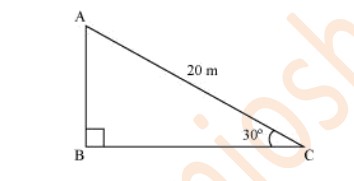
Sol. It can be observed from the figure that AB is the pole.
In ΔABC,
AB/AC=sin 30°
AB/20=1/2
AB=10
Therefore, the height of the pole is 10 m.
Q. A tree breaks due to storm and the broken part bends so that the top of the tree touches the ground making an angle 30° with it. The distance between the foot of the tree to the point where the top touches the ground is 8 m. Find the height of the tree.
Sol. 
Let AC was the original tree. Due to storm, it was broken into two parts. The broken part A’B is making 30° with the ground.
In ΔA'BC
BC/A'C=tan 30°
BC/8=1/√3
BC=8/√3m
A'C/A'B=cos 30°
8/A'B=√3/2
A'B=16/√3m
Height of tree =A’B+ BC
=8/√3m+16/√3m
=8√3m
Q. A contractor plans to install two slides for the children to play in a park. For the children below the age of 5 years, she prefers to have a slide whose top is at a height of 1.5 m, and is inclined at an angle of 30° to the ground, whereas for elder children, she wants to have a steep slide at a height of 3m, and inclined at an angle of 60° to the ground. What should be the length of the slide in each case?
Sol. It can be observed that AC and PR are the slides for younger and elder children respectively.
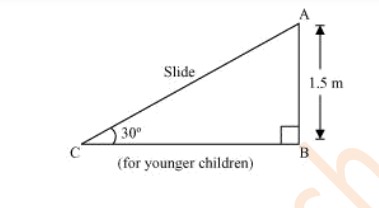
In ΔABC,
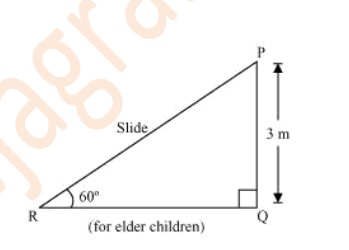
AB/AC=sin 30°
1.5/AC=1/2
AC=3
In ΔPQR,
PQ/PR=sin 60°
3/PR=√3/2
PR=2√3
Therefore, the lengths of these slides are 3 m and 2√3m.
Q. The angle of elevation of the top of a tower from a point on the ground, which is 30 m away from the foot of the tower, is 30°. Find the height of the tower.
Sol. 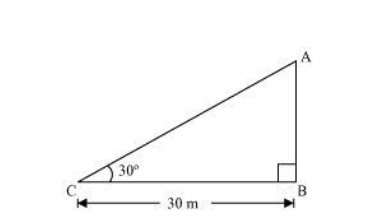
Let AB be the tower and the angle of elevation from point C (on ground) is 30°.
In ΔABC,
AB/BC=tan 30°
AB/30=1/√3
AB=10√3
Therefore, the height of the tower is 10√3.
Q. A kite is flying at a height of 60 m above the ground. The string attached to the kite is temporarily tied to a point on the ground. The inclination of the string with the ground is 60°. Find the length of the string, assuming that there is no slack in the string.
Sol. 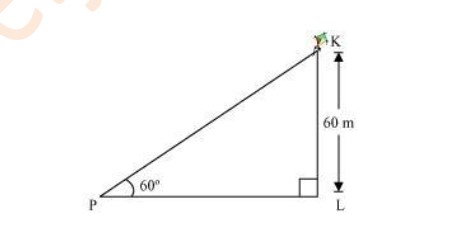
Let K be the kite and the string is tied to point P on the ground.
In ΔKLP,
KL/KP=sin 60°
60/KP=√3/2
KP=40√3
Hence, the length of the string is 40√3.
Q. A 1.5 m tall boy is standing at some distance from a 30 m tall building. The angle of elevation from his eyes to the top of the building increases from 30° to 60° as he walks towards the building. Find the distance he walked towards the building.
Sol. 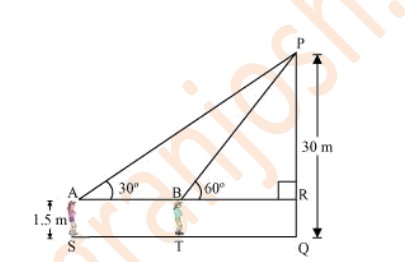
Let the boy was standing at point S initially. He walked towards the building and reached at point T.
It can be observed that
PR=PQ-RQ
=(30-1.5)m=28.5m=57/2m
In ΔPAR,
PR/AR=tan 30°
57/2AR=1/√3
AR=57√3/2m
In ΔPRB,
PR/BR=tan 60°
57/2BR=√3
BR=19√3/2m
ST=AB
=AR-BR
=57√3/2-19√3/2
=38√3/2
19√3m
Hence, he walked 19√3m towards the building.
Q. From a point on the ground, the angles of elevation of the bottom and the top of a transmission tower fixed at the top of a 20 m high building are 45° and 60° respectively. Find the height of the tower.
Sol. 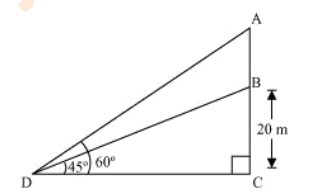
Let BC be the building, AB be the transmission tower, and D be the point on the ground from where the elevation angles are to be measured.
In ΔBCD,
BC/CD=tan 45°
20/CD=1
CD=20m
In ΔACD,
AC/CD=tan 60°
AB+BC/CD=√3
AB+20/20=√3
AB=20(√3-1)m
Therefore, the height of the transmission tower is 20 (√3-1) m.
Q. A statue, 1.6 m tall, stands on the top of a pedestal. From a point on the ground, the angle of elevation of the top of the statue is 60° and from the same point the angle of elevation of the top of the pedestal is 45°. Find the height of the pedestal.
Sol. 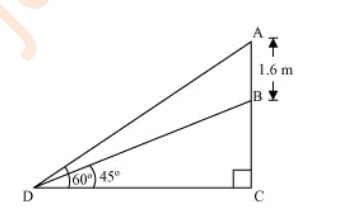
Let AB be the statue, BC be the pedestal, and D be the point on the ground from where the elevation angles are to be measured.
In ΔBCD,
BC/CD=tan 45°
BC/CD=1
BC=CD
In ΔACD,
AB+BC/CD=tan 60°
AB+BC/BC=√3
1.6+BC=BC√3
BC=1.6/√3-1
BC=1.6/√3-1×√3+1/√3+1
BC=0.8 (√3+1)
Therefore, the height of the pedestal is 0.8 (√3+1) m.
Q. The angle of elevation of the top of a building from the foot of the tower is 30° and the angle of elevation of the top of the tower from the foot of the building is 60°. If the tower is 50 m high, find the height of the building.
Sol. 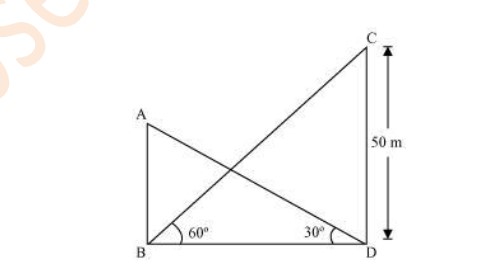
Let AB be the building and CD be the tower.
In ΔCDB,
CD/BD=tan 60°
50/BD=√3
BD=50/√3
In ΔABD,
AB/BD=tan 30°
AB/BD=1/√3
AB=50/√3.1/√3
AB=50/3m
AB=16 2/3 m
Therefore, the height of the building is 16 2/3 m.
Q. Two poles of equal heights are standing opposite each other on either side of the road, which is 80 m wide. From a point between them on the road, the angles of elevation of the top of the poles are 60° and 30°, respectively. Find the height of the poles and the distances of the point from the poles.
Sol. 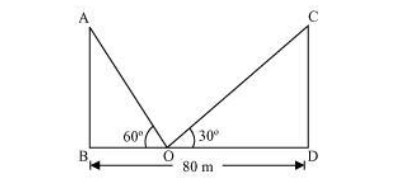
Let AB and CD be the poles and O is the point from where the elevation angles are measured.
In ΔABO,
AB/BO=tan 60°
AB/BO=√3
BO=AB/√3
In ΔCDO,
CD/DO=tan 30°
CD/80-BO=1/√3
CD√3=80-BO
CD√3=80-AB/√3
CD√3+AB/√3=80
Since the poles are of equal heights,
CD=AB
CD√3+CD/√3=80
CD [√3+1/√3]=80
CD[4/√3]=80
CD=20√3m
BO=AB/√3=CD/√3=20m
DO=BD-BO=(80-20)m=60 m
Therefore, the height of the poles is 20√3m and the point is 20 m and 60 m far from these poles.
Q. A TV tower stands vertically on a bank of a canal. From a point on the other bank directly opposite the tower, the angle of elevation of the top of the tower is 60°. From another point 20 m away from this point on the line joining this point to the foot of the tower, the angle of elevation of the top of the tower is 30°. Find the height of the tower and the width of the canal.
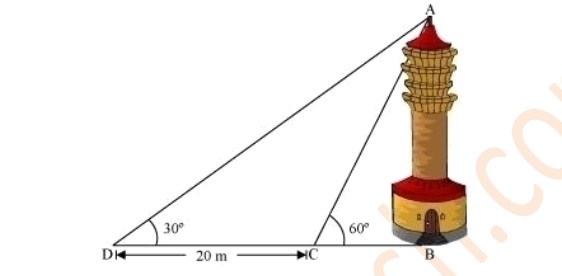
Sol. In ΔABC,
AB/BC=tan 60°
AB/BC=√3
BC=AB/√3
In ΔABD,
AB/BD=tan 30°
AB/BC+CD=1/√3
AB/AB/√3+20=1/√3
AB√3/AB+20√3=1/√3
3AB=AB+20√3
2AB=20√3
AB=10√3
BC=10 m
Therefore, the height of the tower is 10√3 m and the width of the canal is 10 m.
Q. From the top of a 7 m high building, the angle of elevation of the top of a cable tower is 60° and the angle of depression of its foot is 45°. Determine the height of the tower.
Sol. 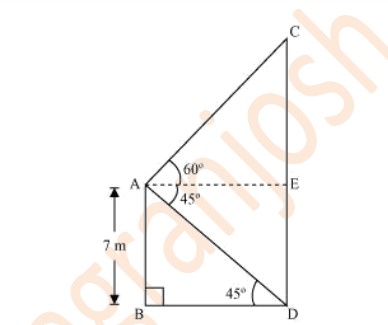
Let AB be a building and CD be a cable tower.
In ΔABD,
AB/BD=tan 45°
7/BD=1
BD=7 m
In ΔACE,
AE=BD=7 m
CE/AE=tan 60°
CE/7=√3
CE=7√3 m
CD=7√3 +7
CD=7 (√3+1) m
Therefore, the height of the cable tower is 7 (√3+1) m.
Q. As observed from the top of a 75 m high lighthouse from the sea-level, the angles of depression of two ships are 30° and 45°. If one ship is exactly behind the other on the same side of the lighthouse, find the distance between the two ships.
Sol. 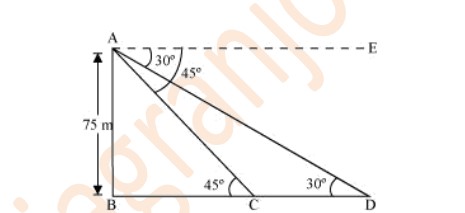
Let AB be the lighthouse and the two ships be at point C and D respectively.
In ΔABC,
AB/BC=tan 45°
75/BC=1
BC=75 m
In ΔABD,
AB/BD=tan 30°
75/BC+CD=1/√3
75/75+CD=1/√3
75√3=75+CD
CD=75 (√3-1) m
Therefore, the distance between the two ships is 75 (√3-1) m.
Q. A 1.2 m tall girl spots a balloon moving with the wind in a horizontal line at a height of 88.2 m from the ground. The angle of elevation of the balloon from the eyes of the girl at any instant is 60°. After some time, the angle of elevation reduces to 30°. Find the distance travelled by the balloon during the interval.
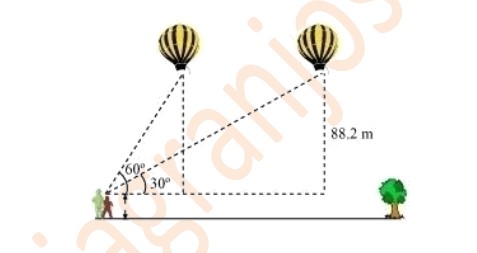
Sol. 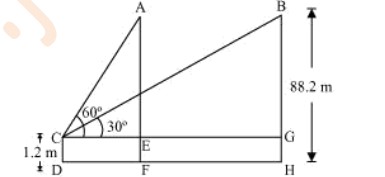
Let the initial position A of balloon change to B after some time and CD be the girl.
In ΔACE,
AC/CE=tan 60°
AF-EF/CE=√3
88.2-1.2/CE=√3
87/CE=√3
CE=29√3m
In ΔBCG,
BC/CG=tan 30°
88.2-1.2/CG=1/√3
87/CG=1/√3
CG=87√3 m
Distance travelled by balloon, EG= CG− CE
EG=87√3-29√3
EG=58√3m
Q. A straight highway leads to the foot of a tower. A man standing at the top of the tower observes a car at an angle of depression of 30°, which is approaching the foot of the tower with a uniform speed. Six seconds later, the angle of depression of the car is found to be 60°. Find the time taken by the car to reach the foot of the tower from this point.
Sol. 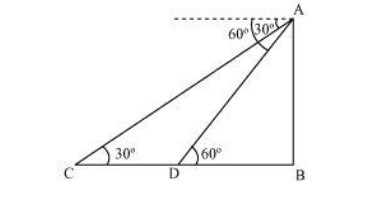
Let AB be the tower,
Initial position of the car is C, which changes to D after six seconds.
In ΔADB,
AB/DB=tan 60°
AB/DB=√3
DB=AB/√3
In ΔABC,
AB/BC=tan 30°
AB/BD+DC= 1/√3
AB√3=BD+DC
AB√3=AB/√3+DC
DC=2AB/√3
Time taken by the car to travel distance DC=2AB/√3=6 seconds
AB= 3√3
Time taken by the car to travel distance DB=AB/√3=3√3/√3=3 seconds
To download these solutions in pdf, refer to the below link:
| Download NCERT Class 10 Maths Chapter 9 Some Applications of Trigonometry Solutions PDF |
CBSE Video Courses for Class 10 Students
Class 10 students can study effectively for the exams with the help of video courses prepared by the subject matter experts. These video courses will explain the concepts in a simple and interactive manner which will help learners to understand clearly.
Also, check
CBSE Class 10 Maths Syllabus 2024-2025, Download PDF
NCERT Exemplar Solutions for Class 10 Maths
NCERT Book for Class 10 Maths (Revised)
CBSE Class 10 Maths Deleted Syllabus for 2025 Board Exam
Probability Notes: Definition, Types, Formulas, Applications and More
Pythagoras Theorem: Definition, Formula, Proof, Examples and Applications
Prime Numbers: Definition, Properties, Examples, List Upto 1000 and Applications
Comments
All Comments (0)
Join the conversation